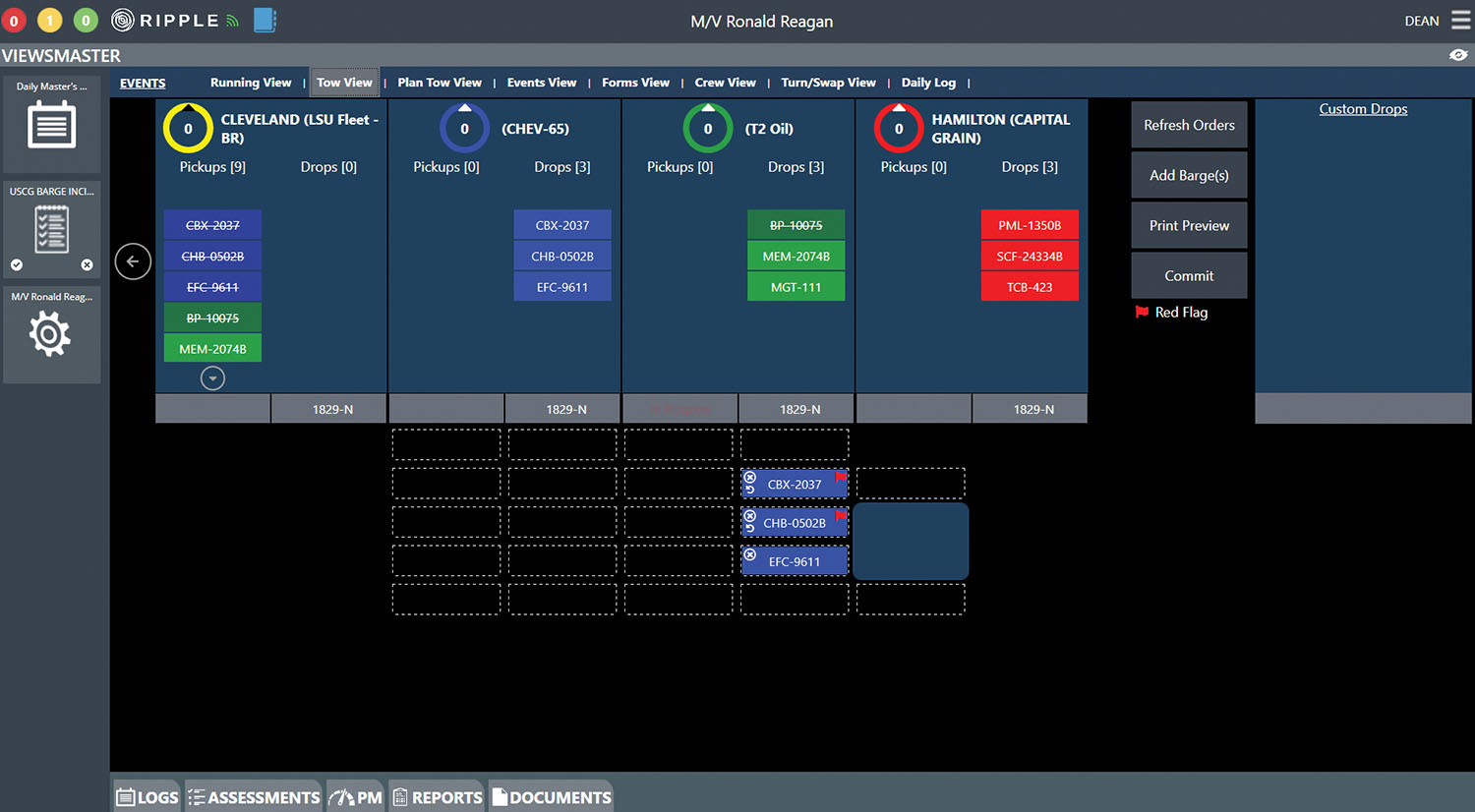Ripple Operations has debuted a suite of software purpose-built for the inland marine industry that works both online and offline so that limited internet connectivity is not a problem.
Ripple, as the software is known, began with tools for tracking compliance but quickly expanded to add maintenance and crew management options, said Chad Mitchell, Ripple Operations CEO.
Boosted by artificial intelligence, Ripple can also put a company’s towing safety management system (TSMS) into action by using a series of “smart triggers.” For that reason, company representatives sometimes describe it as “Sub M in a box.”
Real-Time Capabilities
Dean Shoultz, founder and chief technology officer, explained some of Ripple’s capabilities, including turning TSMS lists into actionable items.
For example, if a vessel is approaching the Vicksburg Bridge, which is notorious in the navigation community, the system knows exactly where the vessel is, how many barges are in tow and what they are carrying and could respond with screen prompts that include approach checklists as configured by users that pop up from 1 to 3 miles in advance. The system also monitors the boat’s speed in real time and can generate alerts back to the office if it detects an anomaly, such as a speed too fast for conditions.
Designed for simplicity of use, the system also has drag and drop graphic capability so that if a boat is dropping off barges at a fleet, the system recognizes the boat is arriving, prompting a screen where the pilot can drag and drop a graphic of the correct barge in the tow diagram at the fleet in an instant instead of making a log entry to note the business transaction, Shoultz said.
Additionally, he said, the system includes prompts such as when it is time for crewmembers to complete an inspection. It can quickly spawn entire maintenance plans, using a “wizard” where crewmembers input data such as their engine type and then select from detailed or simple plans.
What Shoultz calls the “secret sauce” of the system is an intuitive replication engine, leading to a system designed to provide better analytics and reporting while also reducing data entry time and being far less prone to errors. Additionally, he said, the step-by-step, sequential series of screen prompts is easy to understand, and all systems function locally in real time.
“Our system is designed to be functional at all times, independent of connectivity,” Shoultz said.
Safety And Convenience
Mitchell said that while Ripple includes many different tools for mariners, all of them have the end goal of increasing the number of safe miles traveled. It does that, in part, by providing screen prompts so that instead of trying to remember all the steps of a checklist, pilots can focus on what they do best: steering the boat.
Ripple also has benefits for shoreside personnel. For example, if the company suddenly needs to replace a crew member on a vessel, Ripple can quickly generate a list of choices based on factors such as the type of license a mariner has, which people have experience with the boat and how close they live to where the boat is operating.
Those in shoreside operations also appreciate that there are no more cases of forms that were forgotten to be completed or those filled out twice, Mitchell said. Additionally, because Ripple knows exactly where a vessel is, it also automatically logs when it is entering or exiting a taxable waterway.
Ripple offers integration with standard NEMA-compliant devices, including Rose Point. It can also tie in directly to an AIS unit.
“We try to be as accommodating as we can with whatever they already have,” Shoultz said.
Additionally, Mitchell said, while some competitors have designed “closed” systems that prevent exporting data elsewhere, Ripple includes an open, flexible architecture that allows customers to access all of their data so they can use it however they want.
“They built the platform to be configurable so the company’s processes can be built into how it operates rather than forcing companies to operate based on how their system works,” he said.
That may be one of the reasons Ripple is gaining industry attention. While Mitchell said they keep customers’ names confidential, they include one of the largest river businesses headquartered in Paducah, Ky., and support organizations with as many as 5,000 mariners.
Pricing is based on a monthly subscription and is available either scaled to the size of the company and number of vessels or through bundled options. Potential customers may learn more and schedule a demo through the company’s website at rippleoperations.com.
Caption for photo: Ripple’s Tow View feature. Pilots can easily drag and drop a graphic of the correct barge instead of making a log entry to note the business transaction. (Photo courtesy of Ripple Operations)



